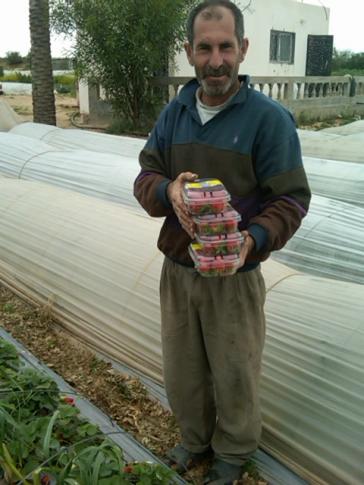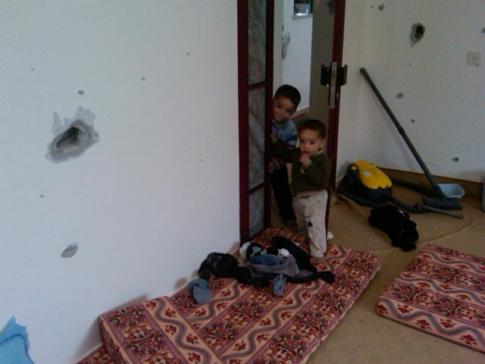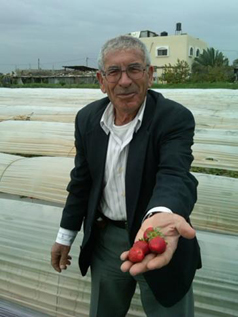Trying to make a living as a farmer in Gaza these days is taking a toll on the family ties so integral to the Palestinian culture. Traditionally, occupations are passed from father to son for generations, and their tie to the land is particularly strong. Before Israel imposed a suffocating blockade on the 14-kilometer-long Gaza Strip in 2007 (as punishment for electing Hamas as its governing party), farmers could make a good living growing carnations and strawberries for export and vegetables for the local market.
But now, sons are watching their fathers struggle just to make ends meet, and are either forced to get second jobs or are looking for different futures for themselves and their families – at the same time that their fathers need them on the farm more than ever, because they can no longer afford to hire additional help.
“Our young people are no longer optimistic about the future; farming seems like a dead end to them,” says Ahmad Shafi, chair of the Gaza Cooperative Association for Produce and Marketing of Vegetables, through an interpreter. Shafi was born to a farmer and has six sons himself – two are now engineers in the United States, three teach as well as farm their family’s 50 dunums (12 acres) and one is still a student. He adds that with 85 percent of Gazans now below the poverty line – including farmers – making it impossible for traditional men to support their families, tension in the home increases. According to the United Nations Development Fund for Women (UNIFEM), reports of domestic violence cases significantly increased both during and after the 2008-9 Israeli invasion – in part due to a loss of dignity and self-sufficiency.

Ahmad Shafy’s brother still farms, but also works as an
accountant.
Prior to the closing of the Israeli “noose,” as many as 35 trucks of produce were exported every working day of the agricultural export season (November-March) — mainly cherry tomatoes, flowers (carnations and roses) and strawberries. In addition, Gazans exported another 35 trucks of goods such as furniture, clothing, processed food, metal products and handicrafts. Gaza exports accounted for 10.8% of the total Palestinian gross domestic product (including the West Bank), valued at $330 million.
All that changed, however, in 2007, when the Israelis imposed its blockade. Estimated annual losses from the inability to export agricultural products alone stand at approximately $32 million, and tens of thousands of people have lost their livelihoods. Flowers and strawberries are the only small bright spot, thanks to a program sponsored by the Dutch government. (Meanwhile, the United States Agency for International Development stopped all funding of projects in Gaza, sending its aid only to the West Bank.) The Dutch government now insists that Israel permit Gaza’s flowers and strawberries to reach European markets as an exception to the ban on all other kinds of export — a ban that has forced other donors to convert development programs into humanitarian handouts.
However, Israel has kept a lid on even that program. For example, the strawberry season begins in November, but Israel did not let any of the fruit leave the Strip until early January, missing much of the holiday season. By that time, product from Egypt and Spain had flooded the market and the price had dropped. According to Shafi, only 55 tons of strawberries have been exported this growing season, compared to an average of 1,800 tons before the siege. As a result, only 300 Palestinians in Gaza still grow strawberries for export, compared to more than 500 before 2007.
“Israel knows exactly what it is doing,” observes Shafi. “It is very political and seems intent on allowing us to do just enough business to survive, but that’s all.”

Ahmad Shafi’s home was in the line of Israeli fire during the 2008/9 invasion. Note the walls damaged by gunshot.
In addition to limiting exports, Israel prevents materials such as insecticides and “starter” strawberry plants from entering Gaza, making it difficult for farmers to continue to grow. Another Israeli tactic, says Shafi, is to publicize the rare openings of the border in such a way that if the farmers don’t export whatever they have – whether the fruit is ready or not – they are blamed for not taking advantage of their neighbor’s “generosity.” Poor-quality fruit is exported as a result.
What’s ironic is that Israel originally encouraged Gazans to grow strawberries. Shafi explains that before the Six-Day (1967) War, northern Gaza was especially famous for its citrus plantations. But then in 1968, Israel — itself a major citrus producer and now in control of Gaza — pushed Gazan farmers to grow strawberries and flowers instead, to stifle any competition. With the two intifadas – and particularly the second, which started in September 2000 – Israeli forces began to bulldoze the groves, saying they gave cover to militants. Fortunately, the sandy soil and “sweet water” from the local wells in the Beit Lahiya neighborhood were perfect for the two crops. Likewise, until 2007, the Gazans’ reliance on Israeli wholesalers made the sector a rare beacon of co-existence.
The siege has darkened that one bright spot. However, the people have farming in their blood and are still fighting, with the help of a few European countries, primarily the governments of the Netherlands and Spain. Mohammad El-Bahry, executive director of the Union of Agricultural Work Committees in Gaza, describes through an interpreter how his organization is working to empower rural women, who are disproportionately represented among the poor, through three centers it has set up in the north, south and central regions. The centers train the women in leadership, teamwork, human rights and vocational skills. Over the last three years, almost 1,000 women have participated.
“To be truly free, both women and men must be able to generate income,” El-Bahry explains. His union represents 29 general agricultural committees, as well as 19 specifically for women.
For example, the women at the union’s centers are being equipped to contribute to the family food and income by raising rabbits and chickens. The meat can be sold as well as put on their own tables, helping to reduce the anemia that is increasingly common among women in the south (42 percent) and north (39 percent) of Gaza. El-Bahry adds that there also is a worrying increase in cancers and birth defects among women in those regions, and the UN has promised to investigate. In addition to poor healthcare, El-Bahry suspects that soil contaminated during repeated Israeli invasions is at fault. Google Earth photos of the Beit Lahiya area over the past 10 years show a dramatic “browning” of the once-lush terrain.
The union has also helped its fellow farmers by consulting on how to cope with the increasing saltiness of the ground water. The poor quality of groundwater is due in part to over-extraction from the aquifer, which has allowed salty seawater to seep in.
“Israel steals much of the good water we have,” he explains, “and then tries to sell it back to us at very high prices.”
Much of the groundwater that is left in Gaza is unfit for human use, and toxic to agriculture. Desalination is extremely expensive (about half the cost of land, says El-Bahry), so farmers have had to switch from crops like eggplants and cucumbers that require sweet water to tomatoes, palm trees and some fruits that can tolerate salt. However, tomatoes, he says, command a much lower price than other crops.
El-Bahry’s union also has worked with the Palestinian Authority to enforce a law exempting them from paying a 14.5 percent sales tax, and set up committees to talk about their rights and increase their role in political and social decision-making. A UN survey conducted among 1,100 households last year found that 85 percent of men and 88 percent of women reported they had not been involved in any consultation on the planning or design of humanitarian assistance in their community. The union wants to change that.
“Farming is a long tradition in Gaza,” says Jameel El-Zaaneen, chairman of the union’s board of directors. “Our entire mission is to preserve that for future generations.”
Our most important fundraising appeal of the year
December is the most critical time of year for Truthout, because our nonprofit news is funded almost entirely by individual donations from readers like you. So before you navigate away, we ask that you take just a second to support Truthout with a tax-deductible donation.
This year is a little different. We are up against a far-reaching, wide-scale attack on press freedom coming from the Trump administration. 2025 was a year of frightening censorship, news industry corporate consolidation, and worsening financial conditions for progressive nonprofits across the board.
We can only resist Trump’s agenda by cultivating a strong base of support. The right-wing mediasphere is funded comfortably by billionaire owners and venture capitalist philanthropists. At Truthout, we have you.
We’ve set an ambitious target for our year-end campaign — a goal of $250,000 to keep up our fight against authoritarianism in 2026. Please take a meaningful action in this fight: make a one-time or monthly donation to Truthout before December 31. If you have the means, please dig deep.
